New Native Garden and Sculpture Park Opens in Perry County
July 6th, 2021
Bill and Jane Allis just built a home garden in Perry County that they’ve decided to share with everybody.
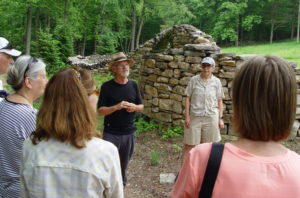
Bill and Jane Allis talk to a tour group at their new Bower Garden in Perry County.
It’s called The Bower, and it’s a new combination native-plant sanctuary and sculpture park that covers 36 acres in the Carroll Twp. countryside not far from Shermans Dale.
Six of those acres is a wildflower meadow alongside a residential garden that’s planted with assorted shrubs, perennials, and small trees (mostly natives) around the Allis’s house and pool.
The remaining 30 acres are woodlands with wetlands, pools, copses of trees, a stumpery, and a mile and a half of trails running through it all.
Ten sculptures complement the plantings throughout, ranging from a three-foot, polished-brass heron to a 67-foot long, 17-ton steel “Ridge and Valley” work representing Pennsylvania’s different eco-regions.
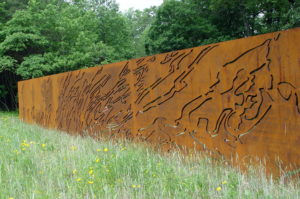
This Ridge and Valley sculpture by Rebecca Rutstein is the first thing visitors see when they enter The Bower’s driveway.
The Allises are welcoming a limited number of visitors at no charge via timed appointments and have plans to make the property more of a widely open public garden. (Note: All available time slots for this year already have been reserved.)
Bill is an environmental engineer (retired from Gannett Fleming) who grew a love of plants at the tropical-plant business his dad ran in Wisconsin in the 1960s and 1970s.
Jane grew up in Washington, D.C., but spent a lot of time in the woods and nature at a get-away place her family owned. She went on to become an early-childhood teacher.
The two met at Dickinson College, got married at 21, and bought their 36 acres of Perry County land the following year.
They raised two sons there, spent the latter 13 years of their careers living in Harrisburg, then moved back to Perry County to retire.
Rather than sit in rocking chairs, the couple hired the renowned D.C. landscape architecture firm of Oehme, van Sweden to come up with a master plan to do something special with their large and diverse property.
“We were so fortunate to be able to have this that we thought we should share our fortune,” says Jane.
Since both Bill and Jane love art and nature, they decided on a concept that’s a naturalistic landscape filled with native plants and sculptures that fit into or reflect nature.

The Allises wanted a naturalistic setting for their sculptures. The Heron by Bertalan Andrasfalvy is in the foreground.
Delaware’s Mt. Cuba Center and the Innisfree Garden in upper New York State are two public gardens that particularly inspired them.
“It sort of goes with our organic philosophy of supporting the environment,” says Jane. “We want to show people they can enjoy birds, bees, and other wildlife in a way they can’t if they have only a lot of plants from other lands.”
They also wanted to make sure the site was inviting to kids – something they said a lot of public gardens they visited didn’t do very well.
The couple hired native plant guru and author Larry Weaner to come up with the planting plan, which was carried out last fall and this spring.
“We had a crew of eight here for two weeks last November,” says Bill. “They planted about 7000 herbaceous plants and 200 trees and shrubs.”
That’s on top of all the planting, invasive-plant clearing, meadow-seeding, and boulder-moving that the Allises themselves have done.
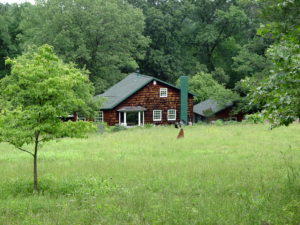
This six-acre meadow makes up the Allises “back yard” behind their house.
Front and center is the meadow, which in a former life was a hayfield.
“Because we had only been mowing it once a year, a lot of native plants were coming back in,” says Jane. “We planted drifts of additional plants to help fill in and disperse seeds faster.”
They figure it’ll hit peak form in two to three years.
Several piles of rocks and boulders that earlier owners created when clearing the land to farm are now home to copses of trees that self-planted – dogwoods, sassafras, black cherry, sweet birch, quaking aspen, and more.
Dead, dying, and out-of-place trees that were yanked are piled roots-up in a woodland stumpery, a form of nature art that’s especially popular in Europe.
The upper two-thirds of the property transitions into a woods’ edge (small trees and woodland shrubs) and then a more mature forest with hardwoods – some a century old – with a floor of mostly ferns and mosses (species the deer haven’t been eating).
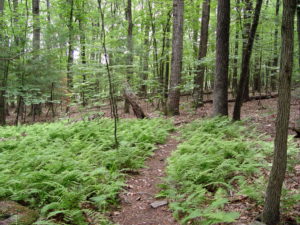
A mile-and-a-half of trails leads through 30 acres of woodlands.
Future plans include a pair of deer fences.
Trails lead to the top of the ridge, where there’s a spring, vernal pools, and a mix of shade-dwelling shrubs and perennials.
Coming back down the far side of the property is a young “pioneer forest” that started encroaching on the former hayfield while the Allises were in Harrisburg.
There’s also a terraced series of stone-lined pools, designed to capture and keep stormwater runoff on site.
“Bill calls it ‘rain gardens on steroids,’” says Jane.
The huge “Ridge and Valley” sculpture is embedded in a meadow garden at the front of the property and is the first thing visitors see when entering the gravel driveway.

A series of pools helps manage stormwater runoff.
All 10 of the sculptures were selected from the 130 applications the Allises got with the help of Bridgette Mayer Art Advisors.
Five artists are local to Pennsylvania, and three are from as far away as Europe. The sculptures went in last summer.
Now comes the intriguing part of watching the new landscape grow and fill in… and the labor-intensive part of keeping the new trees watered and weeds from creeping into the open areas.
Bill, Jane, and a “helper who likes to dig” are in charge of that, and they’re doing it with no chemical pesticides.
“Native plants are pretty hardy,” says Jane. “A few bugs won’t hurt them.”
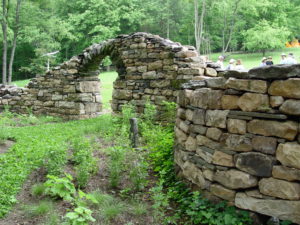
This stone wall, called The Kiss, leads visitors into The Bower’s landscape.
The Allises also are spending a lot of their time showing guests around.
In May, they started offering free tours during two time slots every Wednesday, Thursday, Friday, and Saturday.
When those filled for the whole year, they added more times and those also filled.
“The response has been way more than we expected,” says Jane. “We’ve met some of the most amazing people. Everybody’s been lovely.”
More information is on The Bower’s website. Visits can be scheduled at that same site when openings are available.







